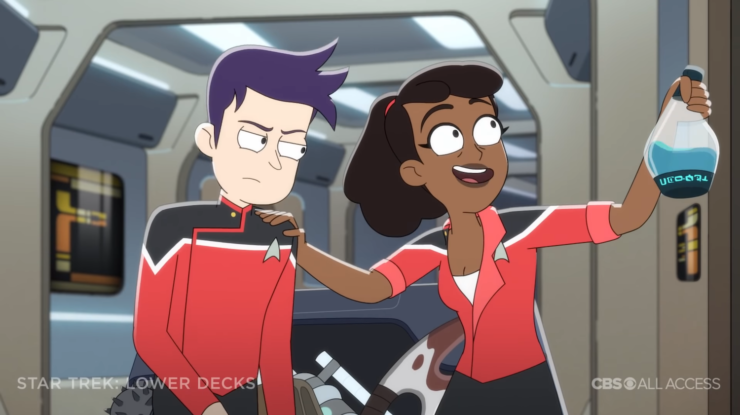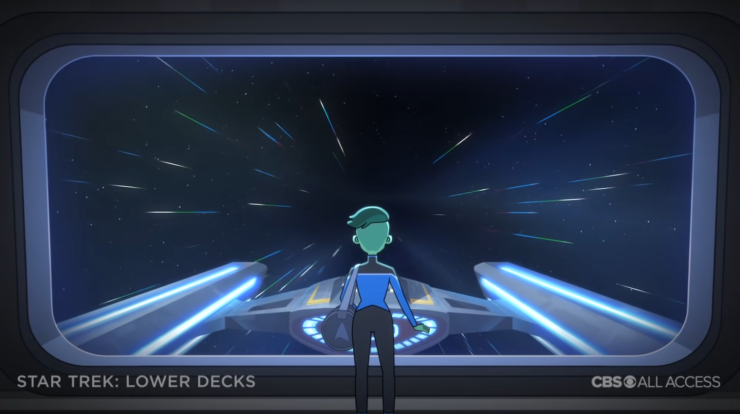In the earliest days of screen entertainment, cartoons were the cool thing that you got before the movie started, produced by the great animators of Walt Disney and Warner Bros. and MGM. But by the 1970s, when the animated Star Trek debuted, animation had devolved into cheap kiddie fare, with the stilted figures produced by Filmation a far cry from what Walt Disney, Chuck Jones, and Hanna-Barbera had been doing three decades before.
But then the 1990s started a revolution in animation (Ren & Stimpy, ReBoot, Rugrats, the work of Bill Plympton, etc.). Now animation is everywhere, and in a huge variety of styles. With CBS committed to lots and lots of Star Trek, doing new animated series only makes sense.
Secret Hideout, Alex Kurtzman and Heather Kadin’s production company that is now in charge of Trek, is producing two animated series, and the first of them debuts today. (The second, Prodigy, will be more geared toward kids and will air on Nickelodeon.) Lower Decks is a notion that has been batting around since the same-titled episode of The Next Generation aired in its seventh season, a phenomenal episode that became its own TV Trope.
Now we have it as the focus of a show, thanks to Mike McMahan, one of the producers of Rick and Morty, and done in a similar animation style to that Adult Swim show.
And it’s almost really good.
[Some spoilers for “Second Contact”]
Parts of it are fantastic. In fact, the overall plot is brilliant, and a perfect template for the show: the U.S.S. Cerritos is making second contact with a planet and setting up a subspace array for the natives. A member of the away team brings a pathogen back on board that turns half the crew into crazed zombies. Meanwhile, two of our main characters have an adventure on the surface, which results in one of them getting covered in gunk, which turns out to be the cure for the zombie plague. The day is saved thanks to the efforts of the junior crew, but the senior officers get all the credit.
This could’ve been a brilliant opening, and instead it’s only a good opening, because the show gets in its own way too much by trying too hard to be funny. Two of the biggest pitfalls of writing comedy are letting the joke go on too long and becoming so in love with a shtick that it gets in the way of the story.

“Second Contact” suffers from both those problems, starting with the very first scene: Ensign Mariner is the drunken crazy person who’s always loud and getting in everyone’s faces and not understanding personal space, a shtick that wears thin after about two seconds, and which the character returns to far too often. Plus the opening bit—which has nothing to do with the rest of the episode, by the way—goes on about thirty seconds too long. Worse, it ends with Mariner slicing Ensign Boimler’s leg open with a bat’leth, which is then ignored thenceforth. I’m not saying we should then have a trip to sickbay and a lesson about playing with bladed weapons while drunk, but to not follow it up at all just feels—I dunno, cheap. And not that funny, unless you find just the act of two people screaming after a brief pause to be hilarious. Which, to be fair, some people do.
Some of the jokes land beautifully. I love that Ensign Rutherford and Ensign Barnes’ date is interrupted by the outbreak of a zombie apocalypse, but they gamely continue their date even as they’re hiding from phaser fire and going EVA to help save the ship. For that matter, when Mariner is just tweaking Boimler and making fun of the senior officers and not being a loud obnoxious drunken moron, she’s way more effective. (It doesn’t help that Tawny Newsome feels the need to shout all her dialogue.) And then the reveal on the planet that she’s been demoted after having gone through some serious craziness allows her psychosis to start to make sense.
Buy the Book


To Sleep in a Sea of Stars
The thing is, that backstory for Mariner means she should’ve turned into Chris Knight from Real Genius—a great mind that finally decided “Fuck it!” and decided to have fun thenceforth because the universe is a crazy place. Unfortunately, McMahan instead chose Bluto Blutarsky from Animal House as a role model, by way of Chris Farley and Vince Vaughn. It’s a poor fit.
Plus, there’s a little too much early-21st-century dudebro in far too many of the characters—including Mariner, despite her being a woman of color. I mean, it’s one thing if our titular lower-decks folk are goofs, but we also see two high-ranking officers (one of whom is the first officer) who go on about getting a beer together after an away mission in a manner that wouldn’t be out of place in a Manhattan office building in the 2010s (chest bumps, finger-pointing, “that’s what I’m talkin’ about!”), and it just throws me out of the story.
Boimler is a bit too gormless, the nerdy, earnest Starfleet officer who aspires to command, who’s the square made fun of by Mariner’s jock, a dynamic that was hoary forty years ago and hasn’t aged all that well. Still, at least Jack Quaid makes Boimler mostly likeable in a schlubby way. Still, between him and Mariner, our two leads are not nearly as compelling as they could be.

Luckily, the supporting cast picks up the slack. Noël Wells is a delight as the naïve enthusiastic Ensign Tendi (I love how she fangoobers everything that she encounters, from the view of outer space to the holodeck to getting to work with command-track officers to the fact that she’s living through a zombie apocalypse, and every moment is the best thing ever), Jerry O’Connell is great fun as Commander Ramson, and I love seeing a woman of color as the ship’s captain, and Captain Freeman is voiced with arrogant dignity by Dawnn Lewis (plus the reveal that she’s Mariner’s mother lands perfectly).
But the best is the snotty Caitian chief medical officer, Dr. T’Ana, voiced with superlative crankiness by Gillian Vigman. I really hope we see more of her, as she’s rapidly becoming my favorite character.
The general theme, that there’s stuff going on belowdecks that may not be of earth-shattering importance, but is still relevant to the operation of the ship, is a good one, as is the notion that the senior staff takes all the credit even if they don’t do all the work. Plus I like that the Cerritos isn’t a top-of-the-line ship, that these aren’t the best and the brightest, but just the workaday Starfleet folk that don’t normally get to star in TV shows. (Of course, some folks will point out that The Orville did the same thing…) I adore the notion of “second contact,” the team that has to do all the drudge work after first contact.
There’s comedy to be mined here, we’ll just have to see if McMahan and his staff can curb their worst instincts and trust the situations to provide the humor without having to force it.
Random thoughts:
- The opening credits are, at once, hilarious and disappointing. The tone is set by the images of the Cerritos doing things like running away from a fight with the Romulans and Borg, crashing into things, and having a giant space monster sucking on the nacelles. But the graphics and setup are all basically the same as The Next Generation, down to using the same font, which is disappointing. Every other Trek show has had its own unique credits sequence, and the other CBSAA shows in particular have had superlative opening credits sequences.
- Rutherford has cybernetic implants, which were apparently designed by Vulcans, so they suppress his emotions. They’re also glitchy. Mariner adjusts them so he can feel again, which allows him to be nervous about his date with Barnes. (Rutherford also looks a little too much like Cyborg from the Teen Titans…) Also, in an amusing touch, we see a crewperson walking past while wearing a VISOR.
- I’m wondering how long it will be before the whole crew finds out that Mariner is the captain’s daughter.
- On the one hand, the notion that a pathogen would come on board from a bug bite and not be stopped by the transporter’s biofilter is ridiculous. On the other hand, the biofilter isn’t 100% perfect. On the third hand, the notion that a Starfleet officer wouldn’t go to sickbay after that bug bite is ridiculous. On the fourth hand, we have Joe Tormolen…
- CBS’s web site has this taking place in 2380, which is a year after Nemesis. The uniforms are pretty similar to the ones we’ve seen Starfleet personnel wearing in Picard, so presumably the change from the uniforms that debuted in First Contact happened shortly after Shinzon’s coup on Romulus…
- Mariner has a holodeck program called “All Nude Olympic Training Facility” because of course she does. (Tendi’s comment: “Wow, this is a very detailed program.”) Honestly, you know that’s what most people use the holodeck for…
- I’d been avoiding doing a “Random thoughts” section for my previous reviews of Trek shows on CBSAA—not for any good reason, but just because it’s so common now—however, I think it’s a fitting feature for a review of a half-hour comedy.
Keith R.A. DeCandido has been reviewing each of the CBS All Access Star Trek shows—Discovery, Short Treks, Picard—for this site, and has also done rewatches of the original Star Trek, The Next Generation, Deep Space Nine, and Voyager (that last still running twice a week). His next novel is the collaborative military science fiction novel To Hell and Regroup (written with David Sherman), coming soon from eSpec Books, and his most recent short story is “Materfamilias,” an urban fantasy story in Bad Ass Moms from Crazy 8 Press.










